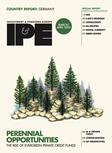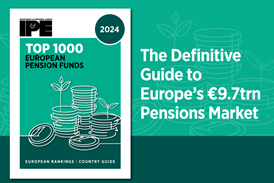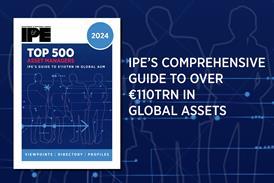Latest from IPE Magazine – Page 41
-
 Opinion Pieces
Opinion PiecesDenmark: Seeking answers on unlisted valuations
The perennial problem of how unlisted assets should be valued has reared its head in Denmark. Data collated by one financial adviser on pension funds’ 2022 private equity investments has led to worries about an apparent black-box approach to valuation processes.
-
 Special Report
Special ReportPension funds on the record: The benefits of a themed portfolio
European pension funds are increasingly organising portfolios according to ‘themes’. Here are two examples of thematic investing in equities
-
 Interviews
InterviewsAP4: A pension fund investing 40 years into the future
Niklas Ekvall (pictured), CEO of Fjärde AP-fonden (AP4), one of the Swedish buffer funds, talks to Carlo Svaluto Moreolo about building a robust and sustainable long-term portfolio
-
 Opinion Pieces
Opinion PiecesUS: Sponsors back pension buyouts
In 2022, pension risk transfer (PRT) deals in the US reached a record of over $50bn (€46.5bn), according to estimates. And many industry observers expect demand from plan sponsors for PRT solutions to remain strong in 2023.
-
 Features
FeaturesPensionsEurope: Not all doom and gloom for 2022
After the bumper investment returns of 2021 – the best that many pension funds had ever experienced – last year’s results were disappointing.
-
 Features
FeaturesFresh views on emerging markets
Despite a large, heterogeneous universe of opportunities across countries that have little or no commonality, risk contagion in the emerging market universe is still an issue, highlighted most dramatically by the 1997 Asian crisis and the risk on/risk off capital movements after the 2007-08 global financial crisis.
-
 Features
FeaturesAccounting: Happy birthday to the ISSB
The International Sustainability Standards Board (ISSB) finds itself at a crossroads as it marks its first anniversary. On the one hand, it is redeliberating its first two sustainability standards and could finalise and issue them during the first half of this year.
-
 Features
FeaturesResearch: Thematic investing is set to attract fresh capital
In the second article on the new Amundi-Create Research survey, Vincent Mortier and Amin Rajan highlight pension plans’ interest in thematic investing
-
 Opinion Pieces
Opinion PiecesGuest viewpoint: The importance of asking the right questions about derivatives and net zero
“What is the carbon footprint of my portfolio?” is thought as the most dangerous question in sustainable investing. But do investors stop and ask: “Why am I measuring the carbon footprint? And how am I planning to manage it?”
-
 Features
FeaturesDid smart beta go ‘horribly wrong’?
In 2016, we published a paper titled ‘How can ‘smart beta’ go horribly wrong?’, the first in a series on the future of factor investing and other forms of so-called smart beta. Did smart beta go horribly wrong? Yes and no.
-
 Interviews
InterviewsImpax rides the sustainability wave
One investment analyst sums up Impax Asset Management as a “pure sustainability play”. And certainly, according to founder and CEO Ian Simm, the core thesis of Impax is to “make the most of the investment opportunities offered by the transition to a more sustainable economy”. These are “on the scale of the Industrial Revolution”, Simm believes.
-
 Features
FeaturesIs the US heading for a soft landing?
Rare though they are in history, a soft landing for the US economy seems to be the consensus forecast, a view aided by news of a sharp contraction in the Institute of Supply Management (ISM) Services Purchasing Managers index in December. The jobs market also looks like it is slowing down and there are signs of a cooling off in wages, with lower-than-expected average hourly earnings reported in December’s non-farm payroll report.
-
 Features
FeaturesAhead of the curve: Time to automate collateral management
The resilience of financial markets has been tested several times in recent years, from the so-called ‘dash for cash’ at the start of the coronavirus pandemic in March 2020 to the spike in UK Gilt yields in September 2022.
-

-
 Features
FeaturesQontigo Riskwatch - February 2023
*Data as of 30 December 2022. Forecast risk estimate for each index measured by the respective US, World and Emerging Markets Qontigo model variants
-
 Features
FeaturesIPE Quest Expectations Indicator: February 2023
Russian attacks against Ukrainian civilians are hampered by efficient air defence. With weapons for the Ukrainian military on the way, a new offensive seems imminent. US President Joe Biden’s troubles over classified documents are a relief for Republicans. The threat of a US-EU trade conflict over China is growing as both sides retreat into nationalistic behaviour. In the UK, Conservatives are under threat of predicted historic losses, while Prime Minister Rishi Sunak so far has done nothing to repair relations with the EU.
-
 Features
FeaturesHigh yield bonds: do your homework
Last year, European bond markets were struck by a toxic a combination of geopolitical, economic and market tensions. The picture has improved with the dawning of 2023, although the markets will continue to experience bouts of volatility and uncertainty will persist. High yield is back on the agenda, but selectivity and careful analysis will be key in identifying the right opportunities.
-
 Country Report
Country ReportCountry Report – Pensions in Central & Eastern Europe (January 2023)
Poland’s PPK auto-enrolment system marks its fourth anniversary this month. It can hardly be described as a complete success given the participation rate is stuck at just over a third of the working population. Some initial projections foresaw a 70% takeup level. But with assets approaching €2.5bn and rapidly growing, there is a sense that this is a relatively good outcome for a country with no tradition of independent retirement saving and where the previous second pillar system was radically overhauled just a few years ago, leaving ordinary citizens confused and mistrustful.
-
 Special Report
Special ReportSpecial Report – DC pensions
Workplace pensions can differentiate themselves by their stewardship and engagement programmes. But effective stewardship is generally the preserve of larger defined benefit players and big investment managers. Now, technology means investors in smaller pooled funds can express their proxy voting preferences, shifting the power away from the managers and towards asset owners.
-
 Asset Class Reports
Asset Class ReportsAsset class report – Fixed income
Last year was the worst in recent decades for both government bonds and credit, with portfolio returns worse than most professionals have experienced in their careers. But is the tide finally shifting as inflation starts to moderate and terminal policy rates are in sight? In any case, geopolitical risks and inflation are not set to go away, and recession will inevitably take a toll on corporate issuers.















